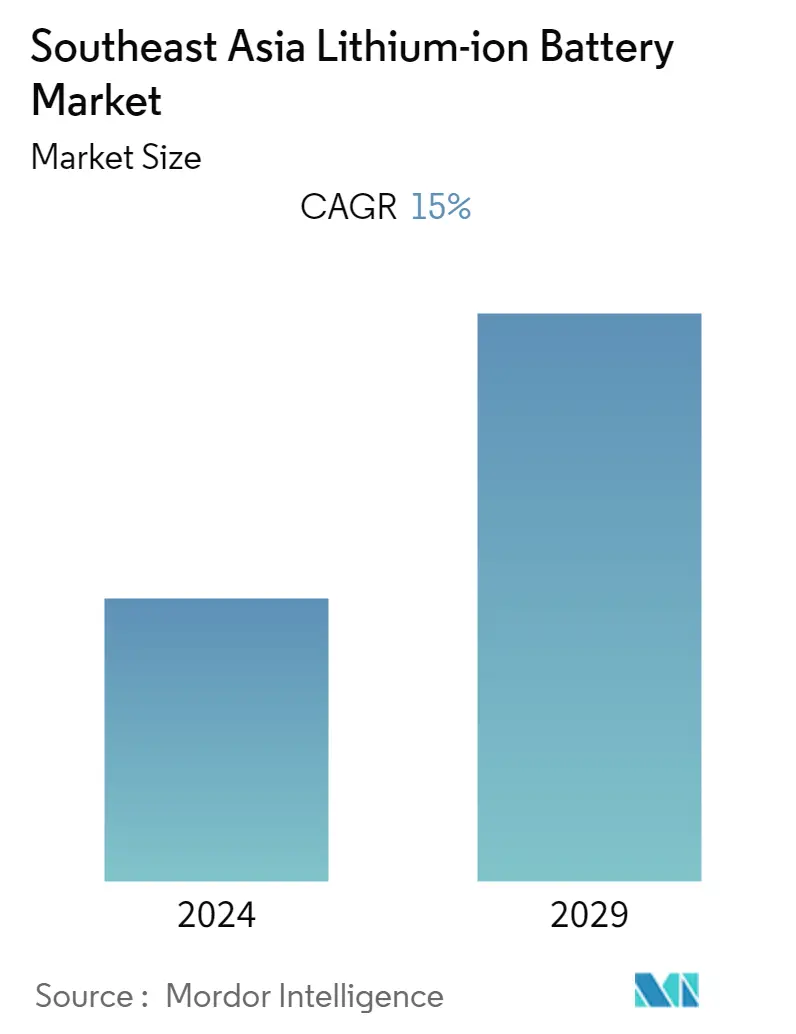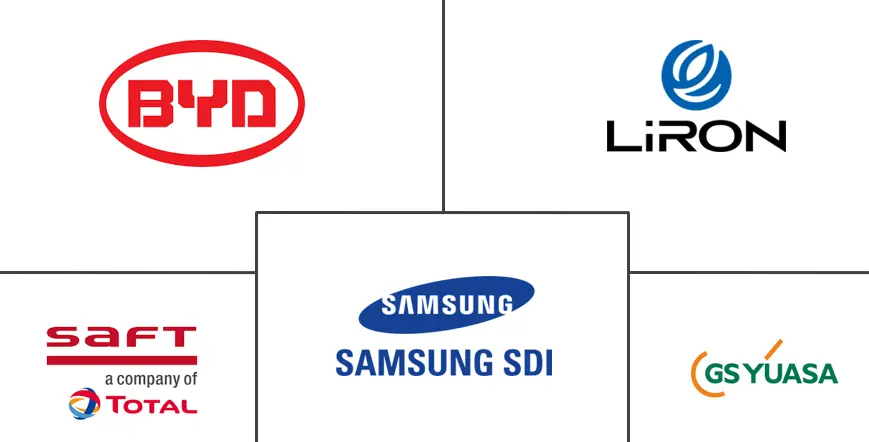Market Size of Southeast Asia Lithium-ion Battery Industry

| Study Period | 2020 - 2029 |
| Base Year For Estimation | 2023 |
| Forecast Data Period | 2024 - 2029 |
| Historical Data Period | 2020 - 2022 |
| CAGR | 15.00 % |
| Market Concentration | Low |
Major Players
*Disclaimer: Major Players sorted in no particular order |
Southeast Asia Lithium-Ion Battery Market Analysis
The Southeast Asia lithium-ion battery market is expected to register a CAGR of 15% during the forecast period.
The market was negatively impacted by COVID-19 in 2020. Presently the market has reached pre-pandemic levels.
- Over the long term, factors like decreasing lithium-ion battery prices and the increasing popularity of electric vehicles are expected to drive the market.
- On the other hand, a mismatch in the demand and supply of raw materials hinders the market growth.
- Nevertheless, plans to integrate renewable energy coupled with battery energy storage systems with the national grids in respective countries are expected to create enormous opportunities for the Southeast Asia Lithium-ion Battery Market.
- Thailand is expected to dominate the market, owing to the increasing demand from various sectors, especially the automotive sector.
Southeast Asia Lithium-Ion Battery Industry Segmentation
Lithium-ion is one of the most popular rechargeable batteries. Lithium-ion batteries power commonly used devices, like mobile phones, electric vehicles, and various other devices. Lithium-ion batteries consist of single or multiple lithium-ion cells and a protective circuit board. They are referred to as batteries once the cell, or cells, are installed inside a device with a protective circuit board.
The Southeast Asia lithium-ion battery market is segmented by Application and Geography. By applications, the market is segmented into Automotive, Industrial, Consumer Electronics, and Other Applications. The report also covers the market size and forecasts for the Southeast Asia lithium-ion battery market across major countries. For each segment, the market sizing and forecasts have been done based on revenue (USD Billion) for all the above segments.
| Application | |
| Automotive | |
| Industrial | |
| Consumer Electronics | |
| Other Applications (Medical Devices, Power Tools, etc.) |
| Geography {Market Size and Demand Forecast till 2028 (for regions only)} | |
| Indonesia | |
| Malaysia | |
| Philippines | |
| Singapore | |
| Thailand | |
| Vietnam | |
| Rest of Southeast Asia |
Southeast Asia Lithium-ion Battery Market Size Summary
The Southeast Asia lithium-ion battery market is poised for significant growth, driven by the increasing adoption of electric vehicles and the declining costs of lithium-ion batteries. The market has rebounded to pre-pandemic levels after the setbacks caused by COVID-19. Key factors propelling this growth include the shift from conventional vehicles to electric vehicles due to fluctuating fuel costs and the need for emission controls. The high energy density, fast recharge capability, and efficiency of lithium-ion batteries make them the preferred choice for powering electric and hybrid vehicles. However, challenges such as a mismatch in the supply and demand of raw materials could hinder market expansion. Despite these challenges, the integration of renewable energy with battery storage systems presents substantial opportunities for market growth.
Thailand is expected to lead the Southeast Asia lithium-ion battery market, bolstered by its robust automotive sector and strategic government policies. The country has established itself as a major automotive production and export hub, with significant investments in electric vehicle production. Government incentives, such as tax reductions and subsidies, are aimed at boosting the production and adoption of electric vehicles, including plug-in hybrids and hybrids. These initiatives are expected to drive demand for lithium-ion batteries in the region. Additionally, the development of data centers under the Thailand 4.0 Programme is anticipated to further increase battery demand. The market is characterized by fragmentation, with major players like BYD Co. Ltd., Samsung SDI Co., Ltd., and others actively participating in the region's growth. Collaborative ventures, such as the joint venture in Thailand to build a gigafactory, highlight the region's potential in the electric vehicle and stationary storage markets.
Southeast Asia Lithium-ion Battery Market Size - Table of Contents
-
1. MARKET OVERVIEW
-
1.1 Introduction
-
1.2 Market Size and Demand Forecast in USD billion, till 2028
-
1.3 Recent Trends and Developments
-
1.4 Government Policies and Regulations
-
1.5 Market Dynamics
-
1.5.1 Drivers
-
1.5.2 Restraints
-
-
1.6 Supply Chain Analysis
-
1.7 Porter's Five Forces Analysis
-
1.7.1 Bargaining Power of Suppliers
-
1.7.2 Bargaining Power of Consumers
-
1.7.3 Threat of New Entrants
-
1.7.4 Threat of Substitute Products and Services
-
1.7.5 Intensity of Competitive Rivalry
-
-
-
2. MARKET SEGMENTATION
-
2.1 Application
-
2.1.1 Automotive
-
2.1.2 Industrial
-
2.1.3 Consumer Electronics
-
2.1.4 Other Applications (Medical Devices, Power Tools, etc.)
-
-
2.2 Geography {Market Size and Demand Forecast till 2028 (for regions only)}
-
2.2.1 Indonesia
-
2.2.2 Malaysia
-
2.2.3 Philippines
-
2.2.4 Singapore
-
2.2.5 Thailand
-
2.2.6 Vietnam
-
2.2.7 Rest of Southeast Asia
-
-
Southeast Asia Lithium-ion Battery Market Size FAQs
What is the current Southeast Asia Lithium-ion Battery Market size?
The Southeast Asia Lithium-ion Battery Market is projected to register a CAGR of 15% during the forecast period (2024-2029)
Who are the key players in Southeast Asia Lithium-ion Battery Market?
BYD Co. Ltd., LiRON LIB Power Pte Ltd, Saft Groupe SA, Samsung SDI Co., Ltd. and GS Yuasa Corporation are the major companies operating in the Southeast Asia Lithium-ion Battery Market.

